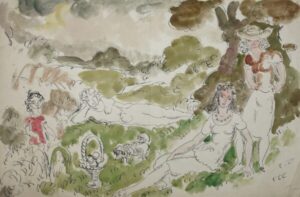Read, Harold Hope (1881-1959)
Harold Hope Read had a real flair for depicting narrative scenes, with figures engaged in animated interactions and exchanges. He produced a number of paintings and drawings depicting upper class society in a series he titled High Life. His work often has elements of playfulness, humour and satire. He was remarkably skilled in a variety of drawing techniques and media, excelling in combining ink and graphite, charcoal, pastel and washes. He produced many cartoons for publication, including eleven contributed to Punch Magazine between 1905 and 1922.
Born into a Quaker family in Greenwich in 1881, Harold Hope Read studied art and went on to have studios at Bolton Studios, South Kensington and later, in 1910, at College Place, Brighton. In Brighton he had connections with the celebrated artists William Orpen (who also had a studio at College Place) and William Rothenstein, brother-in-law to Orpen’s wife and younger brother of Charles Lambert Rutherston, who was Hope Read’s friend and patron. It is thought that it was this exposure to wealthy clientele that provided inspiration for Hope Read’s High Life series. Hope Read’s patron Charles Lambert Rutherston (whose fortune came from an inherited woollen business) was an important patron of young British artists and collector, particularly of works by members of the New English Art Club. Rutherston gifted works, including those by Harold Hope Read, to the people of Manchester, now known as the Rutherston Gift at Manchester City Art Gallery. He also donated to the National Gallery, London and the British Museum.
In the 1930s Hope Read moved to Tunbridge Wells in Kent, where he lived an unconventional and bohemian lifestyle with Hilda, his live-in housekeeper, life model and mistress. He regularly exhibited at the New English Art Club, Alpine Gallery, Royal Institute of Painters in Watercolours, National Society of Painters Sculptors and Gravers, The Pastel Society and the National Society of British Artists. He exhibited at the Royal Academy in 1927.
Showing the single result
